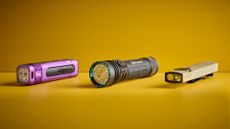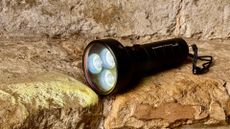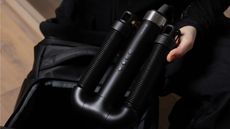Outdoor Tech
The latest Outdoor Tech breaking news, comment, reviews and features from the experts at T3
-

Garmin’s newest adventure gadget just made satellite comms feel unexpectedly… familiar
The inReach Mini 3 Plus shrinks big-trip communication into the brand's smallest off-grid device yet
By Matt Kollat Published
-

Olight ArkPro review: a compact no-faff multifunctional flashlight for after-dark adventures
The night is no match for this powerful pocket torch with myriad features and multiple beam options
By Pat Kinsella Published
-

I review power stations as a job, and here are my expert picks from Amazon's Cyber Monday sale
From Jackery and Anker Solix to Bluetti and EcoFlow, here are my top picks from this year's sale
By Matt Kollat Published
-

EcoFlow just dropped its new DELTA 3 Max Plus portable power station early – and added an unexpected Black Friday discount
New power station launches early with a juicy discount
By Matt Kollat Published
-

I’ve sifted through hundreds of garden Black Friday deals – here are 10 gadgets that actually deserve your money
Now's the perfect time to stock up ahead of next spring and summer
By Lizzie Wilmot Published
-

Amazon's best-selling power station is £678 off for Black Friday – and it comes with a 100W solar panel
Jackery's Explorer 1000 v2 is dirt cheap right now
By Matt Kollat Published
-

Olight’s 3-in-1 Arkfeld Ultra drops in price and fans call it “the best torch they've ever owned”
Sleek and powerful, the Arkfeld Ultra costs a little over £80 on Black Friday
By Matt Kollat Published
-

My favourite budget head torch with a 250-lumen light output is cheaper than ever for Black Friday
Silva's Smini Fly is a tiny powerhouse, and now it's a smidge over £30, thanks to this Black Friday deal
By Matt Kollat Published
-

Ledlenser compact hand torch with over 17,000 reviews is one of Amazon’s highest-rated lights and it's nearly half price off with this Black Friday deal
Ledlenser's P7 Rechargeable LED Torch has dropped into stocking-filler price territory
By Matt Kollat Published
-

Olight's "best torch ever" is now 35% off and it’s the Black Friday deal you can't miss if you want a compact torch that reviewers say leaves others "in the shadows"
The Maraduer Mini is the internet's favourite torch, and now it's 35% cheaper at Amazon
By Matt Kollat Published
-

The Leatherman multitool I’ve wanted all year just hit a price that’s too tempting to ignore this Black Friday
The Rev is down to £48!
By Matt Kollat Published
-

The power station that quietly runs my home office setup has fallen by nearly £180 for Black Friday
EcoFlow's superb DELTA 3 Plus is going for a lot less than usual
By Matt Kollat Published
-

Bluetti Apex 300 review: transform your off-grid life
The Apex 300 may just be the answer to all your off-grid quandaries
By Derek Adams Published
-

Hypershell X Series Exoskeleton review: AI-powered trail support at 2kg
I tested the Hypershell X Pro exoskeleton, and it’s fun, futuristic, and faintly ridiculous
By Matt Kollat Last updated
-

Best head torch 2025: hands-free illumination on the trail
Discover the best head torch for brighter paths when you're hiking, running, camping or exploring in the dark
By Matt Kollat Last updated
-

Best torch 2025: illuminate your way through the dark
Get the best torch for camping, night hiking, walking the dog or finding your way in a power cut
By Matt Kollat Last updated
-

Hypershell X Ultra review: the bionic exoskeleton redefining outdoor endurance
Is this bionic endurance aid that encourages average people to double their range and redefine their limits?
By Jon Devo Published
-

Akaso Sight-300 review: see in the dark (just not too far)
Akaso's affordable night-vision monocular can turn pitch black into daylight, but it's not without caveats
By Matt Kollat Published
-

Ledlenser P18R Signature Rechargeable Torch review: when only the brightest of flashlights will do
Supersized Germanic flashlight with a whopping 7,000 lumens of raw sunlight power
By Derek Adams Published
-

Best portable power stations 2025: stay charged anywhere
Stay powered up wherever you go with the best portable power stations
By Matt Kollat Last updated
-

This clever Norwegian gadget is the winter upgrade I didn’t know I needed
The Hedgehog GO might just be the winter upgrade your soggy shoes have been waiting for
By Matt Kollat Published
-

BMW's new EV is incredibly affordable – the bad news is that you may have to get wet
We're absolutely down with that though
By Britta O'Boyle Published
-

I tested the DJI Power 1000 v2, and it’s the best power station upgrade you shouldn’t ignore
DJI’s mid-size power station gets smarter, faster, and more reliable, making it a strong upgrade for anyone who depends on portable energy
By Matt Kollat Published
-

DJI Power 2000 review: a lighter-than-average 3,000W powerhouse with ports galore
For its size and weight, this portable power station punches like a mule
By Derek Adams Published
-

This pocket torch has a big secret that lights up the horizon
The "world’s smallest LEP torch" packs a big punch, but it’s not without limitations
By Matt Kollat Published
-

Hypershell upgrades revolutionary exoskeleton to make long hikes easier than ever
The new X Ultra packs more power and smarter support to help cut effort for serious adventurers
By Lee Bell Published
-

Off-grid mini dishwasher that doesn’t need plumbing and saves 86% water? Yeah, it exists
Loch’s new Capsule Solo runs without plumbing and fits in your van
By Matt Kollat Published
-

Jackery Explorer 3000 V2 review: at last, a high-output portable power station that I can actually lift
The Jackery Explorer 3000 V2’s comparatively low weight is a major coup
By Derek Adams Published
-

Ledlenser just gave its iconic torches a sustainable makeover with serious power inside
The fourth-generation P-Series brings intuitive controls, recycled aluminium housings, and pro-grade lighting
By Matt Kollat Published
